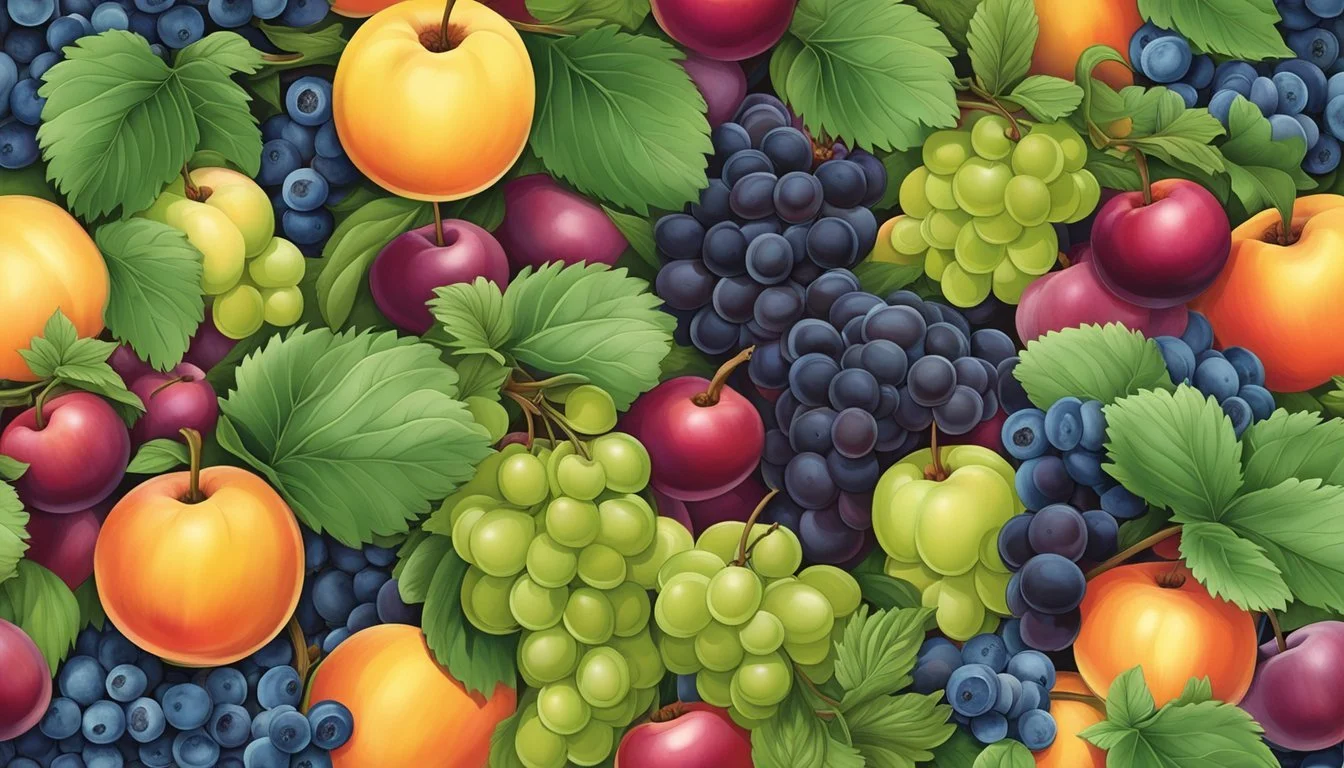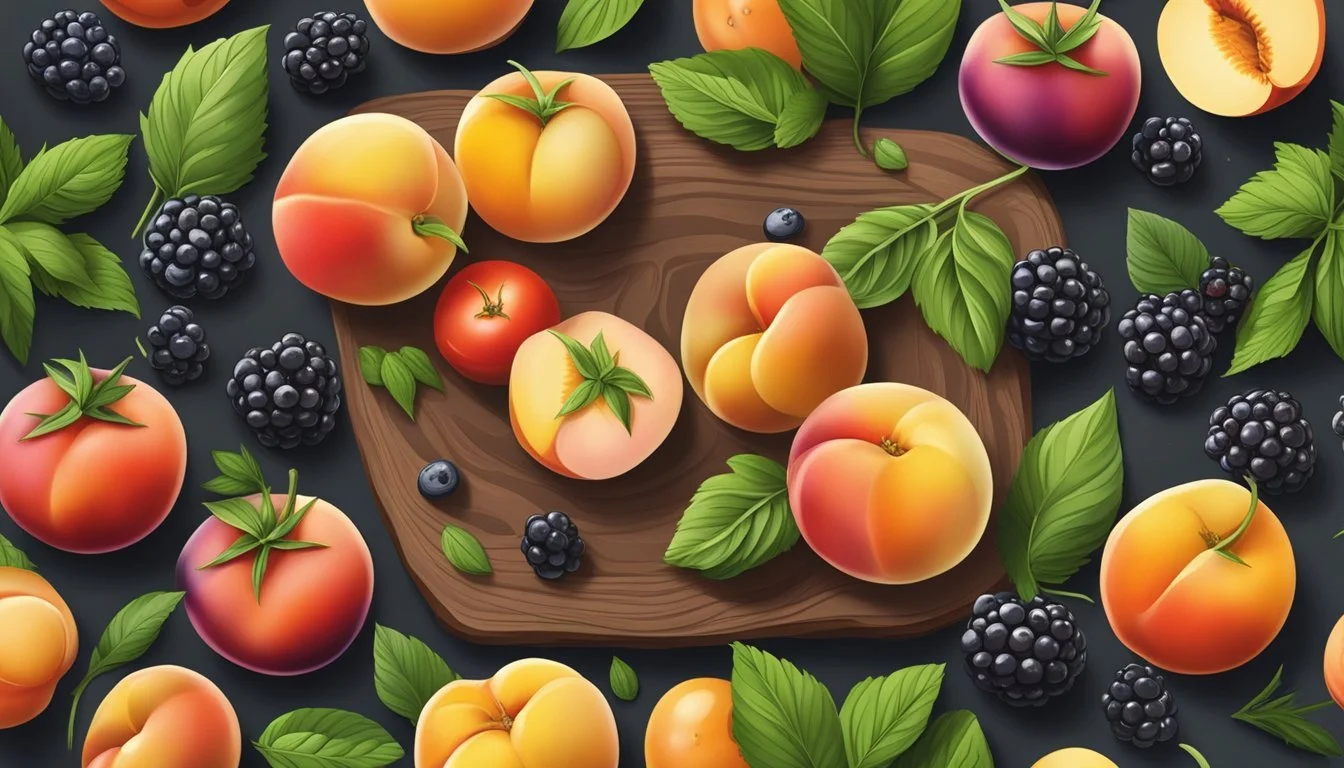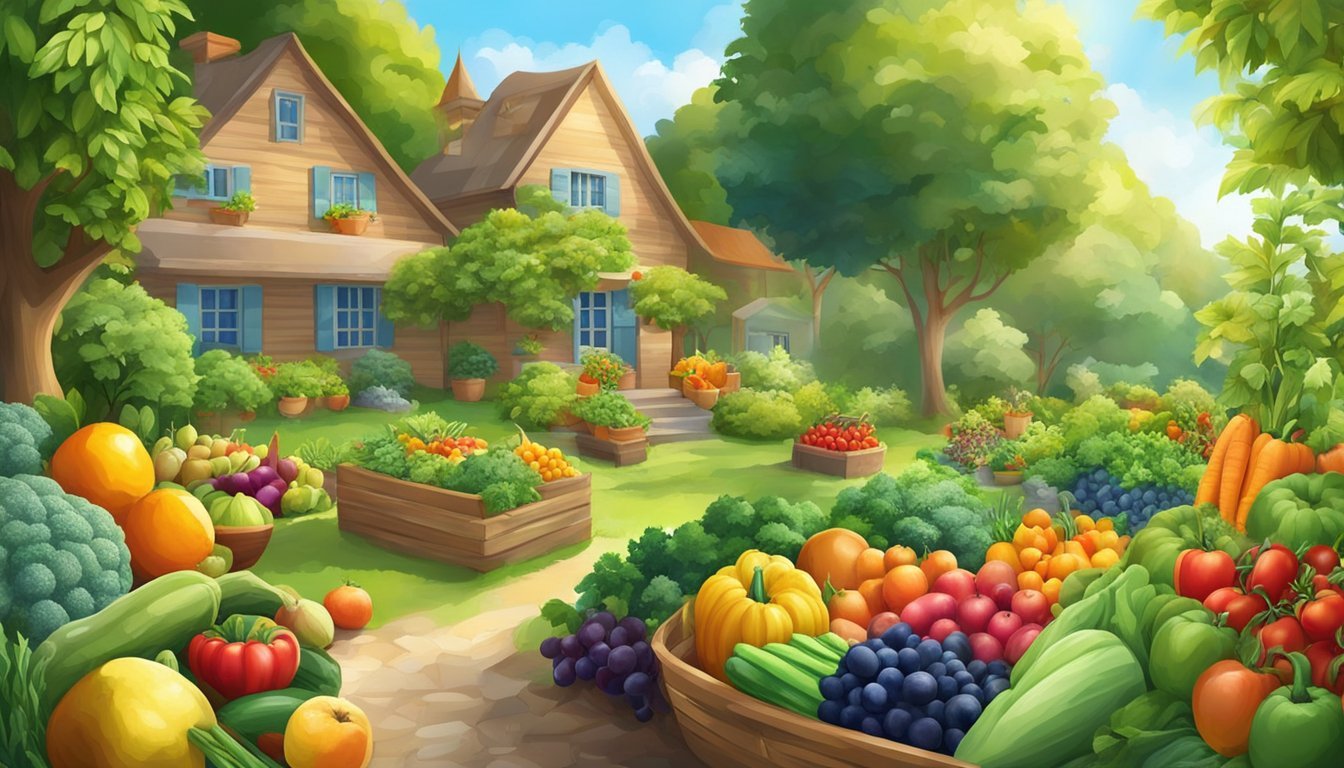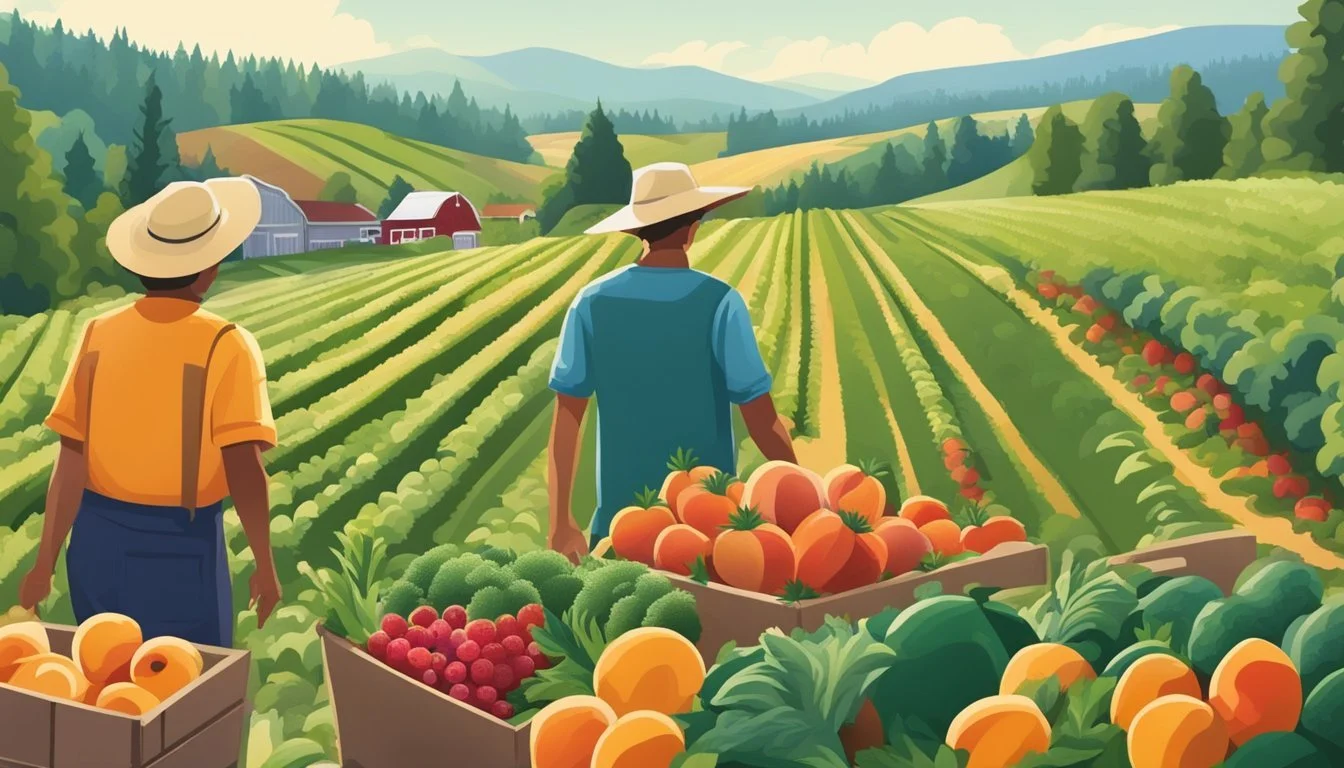Oregon Seasonal Fruit & Vegetables in August
Your Fresh Produce Guide
This Article is Part of our Oregon Seasonal Fruit & Veg Calendar
August in Oregon is a time of agricultural abundance, with a wide variety of fruits (What wine goes well with fruit?) and vegetables reaching peak ripeness. The state's diverse climate and fertile soil conditions make it an ideal environment for growing a rich selection of produce. Consumers and chefs alike look forward to this month for the fresh flavors and nutritional value that come straight from local farms.
Seasonal fruits that are particularly noteworthy at this time include juicy cantaloupes (how long does cantaloupe last?), succulent peaches, and tart cherries (how long do cherries last?), all bursting with flavor after basking in the summer sun. Berries such as blueberries (how long do blueberries last?) and the last of the blackberries (how long do blackberries last?) are also available, offering a perfect blend of sweetness and acidity for any summer dish.
Meanwhile, the vegetable selection is just as impressive. Sweet corn (how long does corn last?) is a highlight in August, along with crisp carrots and versatile cauliflowers (how long does cauliflower last?). Leafy greens like chard and collard greens (how long do collard greens last?) are in abundance as well, providing excellent options for nutritious salads and side dishes. These vegetables are not only at their peak in taste and texture but are also packed with vitamins and minerals essential for a healthy diet.
Understanding Oregon's Growing Season
Oregon's climate is varied, which influences the growing season across different regions of the state. Most areas experience a growing season that is conducive for a wide range of fruits and vegetables, especially during the summer months.
During the summer, the combination of warm days and cool nights is particularly favorable for cultivating a diverse array of produce. The long daylight hours encourage photosynthesis, leading to lush and vibrant growth.
The coastal regions possess a more temperate climate, while the interior valleys, where much of the agriculture takes place, have hotter summers. This distinction allows for different crops to thrive in specific areas. For instance, summer fruits such as cherries and berries flourish in these conditions.
Here's a quick look at August offerings:
Fruits: Cherries see the end of their season in early summer, while peaches and blueberries are abundant.
Vegetables: Corn, carrots, and zucchini are plentiful, making them staples during this time.
Irrigation is a key component in Oregon's agriculture due to the drier summers. Farmers often measure and manage their water usage carefully to ensure optimal growth and sustainability.
The table below highlights typical August produce in Oregon:
Fruits Vegetables Cantaloupes Carrots Peaches Cauliflower Blueberries Celery (how long does celery last?) Chard Collard Greens Corn
This information aligns with Oregon State University Extension Service's guidelines for home gardeners and commercial farmers, reflecting a thorough understanding of the local climate and its associated growing season.
Key Harvests in August
In Oregon, August is the height of the growing season, where an abundance of ripe fruits, robust vegetables, and fragrant herbs fill the farms and gardens. This month offers the peak flavors of summer's bounty.
Fruit Highlights
August brings a sweet and juicy selection of fruits. One can find blackberries, blueberries, peaches, and plums at their ripest. These fruits are not only packed with flavor but also rich in nutrients. Farm-fresh melons are also a staple, with watermelon and various types of melons offering refreshing tastes.
Blackberries: Deeply flavored, perfect for jams.
Blueberries: Ideal for fresh eating or baking.
Peaches: Juicy and fragrant, great for pies.
Plums: Sweet with a hint of tartness, versatile in dishes.
Melons/Watermelon: Hydrating and sweet, excellent in salads or on their own.
Vegetable Highlights
The vegetable harvest in August showcases the vibrant flavors of summer. Corn, cucumbers, eggplant (What wine goes well with eggplant?), green beans, peppers, summer squash, and tomatoes are particularly noteworthy. These vegetables are versatile in culinary use, from fresh salads to grilling.
Corn: Sweet and tender, often eaten directly from the cob.
Cucumbers: Crisp and cool, perfect for salads.
Eggplant (What wine goes well with eggplant?): Rich and meaty, excellent for Mediterranean dishes.
Green Beans: Crisp and versatile, can be used in a variety of recipes.
Peppers: Range from sweet to spicy, adding flavor to any dish.
Summer Squash: Mild and soft, suitable for sautéing or baking.
Tomatoes: Juicy and flavorful, a staple for sauces and sandwiches.
Herb Harvests
Herbs harvested in August like basil (how long does basil last?), mint, parsley, rosemary, sage, and thyme add fragrant notes to dishes and can be used fresh or dried for later use. These herbs are essential for enhancing the natural flavors of both fruit and vegetable dishes.
Basil: Aromatic, a classic with tomatoes and in pesto.
Mint: Refreshing, a perfect addition to drinks and desserts.
Parsley: Bright, used for garnishing and in salads.
Rosemary: Piney, great for roasted meats and vegetables.
Sage: Earthy, commonly used in stuffings and with poultry.
Thyme: Subtle and slightly minty, excellent in sauces and stews.
Preparation and Cooking Tips
In August, Oregon's produce reaches its peak of flavor, offering a bounty of fruits and vegetables ideal for a range of culinary uses. Focusing on the freshness of the season, one can create vibrant dishes that showcase the natural richness of the regional harvest.
Fruit Preparations
Oregon's August fruit offerings are perfect for a variety of sweet and savory dishes. Fresh berries can be used in desserts like pies and crisps, or added to salads for a burst of sweetness. Apricots are excellent when grilled to bring out their natural sugars or diced into a summer salad. When dealing with fruit, gentle handling is key to maintain their delicate structure and flavor integrity.
Grilled Apricots:
Halve and pit apricots.
Grill cut side down until char marks appear.
Berry Salads:
Choose unbruised berries for a fresh taste.
Incorporate into greens with a light vinaigrette.
Vegetable Dishes
Vegetables like eggplant and artichokes (What wine goes well with artichokes?) become the stars of the show in August. With eggplant, dishes such as eggplant parmesan (What wine goes well with eggplant parmesan?) and baba ganoush highlight its versatility and depth of flavor. Artichokes can be steamed to perfection and paired with a lemon garlic aioli or blended into a homemade pesto.
Eggplant Parmesan:
Slice eggplant and bread lightly.
Layer with marinara sauce and mozzarella, bake until bubbly.
Artichoke Pesto:
Blend steamed artichoke hearts with basil, parmesan, and pine nuts (how long do nuts last?).
Use as a spread or sauce for a fresh twist on classic pesto.
Herb Usage
Herbs, though often used sparingly, play a substantial role in accentuating the natural flavors of seasonal produce. They can be chopped and sprinkled over fresh salads or blended into sauces to enhance the main ingredients. For instance, basil complements tomatoes beautifully and can elevate the simplest salad. When creating sauces or pesto, the freshness of the herbs is paramount for achieving that bright, desired flavor.
Basil in Salads:
Tear basil leaves and scatter over tomato mozzarella salad.
Drizzle with balsamic reduction for a flavorsome summer dish.
Herb-infused Sauces:
Finely chop herbs like basil and oregano.
Whisk into dressings or marinades to enliven grilled vegetables.
Food Pairings and Recipes
August in Oregon ushers in a wealth of fresh produce, offering ample opportunities to create vibrant and flavorful dishes. When combining fruits and vegetables during this season, one can achieve a harmonious balance of sweet and savory profiles enhanced by the inclusion of complementary herbs.
Fruit Pairings
Oregon's August fruit harvest is especially generous, featuring fruits like honeydewmelon which pairs excellently with other sweet flavors.
Honeydew and balsamic glaze: Savor the combination of sweet honeydew melon balls drizzled with a rich balsamic reduction.
Blackberries: These can be used in desserts such as blackberry cobbler with a scoop of vanilla ice cream.
Incorporating these fruits into dishes or enjoying them as fresh, standalone snacks can elevate the culinary experience.
Vegetable Combinations
August's vegetable bounty is epitomized by crops like bell peppers, fava beans, (how long do fava beans last?) and fennel (how long does fennel last?).
Bell peppers: Stuff with a mixture of quinoa, diced tomatoes, and corn for a hearty dish.
Fava beans and fennel: Create an elegant salad by blending cooked fava beans with thinly sliced fennel, topped with a lemon vinaigrette.
When combined, these vegetables not only provide essential nutrients but also a complex flavor profile that is both earthy and bright.
Herb Complements
Herbs accentuate the natural flavors of seasonal fruits and vegetables, and edible flowers can add a unique twist to August recipes.
Basil: Pairs well with tomato dishes or can be blended into a classic pesto to be drizzled over roasted vegetables.
Mint: Complements sweet fruits in salads or desserts, adding a refreshingly cool note.
Whether used in a simple garnish or as a key ingredient, herbs are integral in unlocking the full potential of a dish's flavor palette.
Health Benefits of Seasonal Eating
Eating fruits and vegetables in their prime season has a myriad of health benefits. One's nutritional intake may be optimally enhanced, as seasonal produce tends to be fresher and thus richer in vitamins and antioxidants. For instance, August yields a bountiful harvest in Oregon, including an array of nutrient-dense items perfect for a nutritious salad.
When consumers choose seasonal items, they are often selecting produce that is at its peak ripeness. This not only improves flavor but can also mean a higher concentration of valuable nutrients. Seasonal fruits and vegetables are typically harvested at the correct time and therefore may have a better nutrient profile compared to out-of-season produce that may have traveled long distances or been stored for extended periods.
A diet that includes seasonal fruits and vegetables can be more diverse, exposing individuals to a wide range of phytochemicals and nutrients throughout the year. Each variety of produce has a distinct set of nutrients that can contribute to overall health. For instance:
Dark leafy greens, often good for salads, contain iron, calcium, potassium, and vitamins A, C, E, and K.
Berries and stone fruits provide antioxidants such as vitamin C and flavonoids.
This pattern of eating encourages people to explore new flavors and integrate a diverse set of produce into their diet, potentially leading to a more balanced and nutritious dietary pattern. By consuming what is fresh and available, individuals may also benefit from the associated reduction of post-harvest losses and nutrient degradation, ensuring that the produce they eat is as beneficial as possible.
Oregon Agriculture and Markets
Oregon's agricultural landscape in August thrives with a diverse range of fruits and vegetables, thanks to the state's fertile soil and favorable climate. The local farmers markets become bustling centers where the produce of the season is displayed in all its freshness and variety.
Fruits: August is particularly bountiful for fruit in Oregon. The state, known for its berries, sees a surge in the harvest of blackberries, including varieties such as Boysenberries and Marionberries. In addition, farmers offer an assortment of other fruits:
Peaches
Plums
Pears
Vegetables: The summer month also marks the peak season for many vegetables. Shoppers can find:
Corn
Tomatoes
Carrots
Cauliflower
Celery
Chiles
Local farmers and vendors value the connection between the land and the community, taking pride in offering produce that is not only seasonal but often organic and sustainably harvested.
Oregon's farmers markets are more than just points of purchase; they serve as social hubs and educational centers where consumers learn directly from growers about the food they eat. They play a vital role in supporting local agriculture and strengthening the state's food system.
For individuals seeking the freshest, locally-sourced products, August presents the perfect time to visit Oregon's farmers markets, where the abundance of the season is ripe for the taking.
Planning for Future Harvests
Successful harvest planning requires understanding what crops will thrive in the upcoming seasons and how to prepare for their optimal growth. In Oregon, where the climate varies from the coast to inland valleys, gardeners and farmers need to consider the specific timing for planting and harvesting fruits and vegetables to ensure bountiful yields.
September & October Outlook
In September and October, Oregon's agricultural focus shifts towards fall crops. Apples (how long do apples last?) and pears become ripe for picking, and it's an excellent time for growers to assess their orchards for next year's production. Squash, including varieties like butternut and acorn, should be harvested before the first frost to avoid damage. One can use these months to plant garlic; it will overwinter and be ready for early summer harvest.
Fruits: Apples, Pears
Vegetables: Squash, Garlic
Winter Considerations
As winter approaches, the Oregon climate requires robust crops that can handle cooler temperatures. Kale is an ideal vegetable to grow during the colder months, with its ability to withstand frost. Growers should consider planting overwintering arugula (how long does arugula last?) varieties, which can tolerate cool weather and provide early spring greens if protected properly.
Vegetables: Kale, Arugula
Spring Harvest Projections
Looking towards the spring season, farmers should prepare the ground for asparagus, which is one of the first vegetables to harvest in spring. These perennial plants take a few years to establish but provide an early-season crop for many years thereafter. Gardeners can also start seeds indoors for crops like kale and garlic to gain a head start when the ground thaws.
Vegetables: Asparagus, Kale, Garlic
Community Events and U-Picks
August in Oregon is ripe with opportunities for locals and visitors alike to engage in community events and visit U-Pick farms. The state's rich agricultural heritage is showcased through numerous festivals and local farm activities that promote community involvement and provide fresh, seasonal produce.
Local U-Pick Farms:
Apples: Visitors can pick their own varieties, which are abundant in August.
Pears: The majority come from the Mid-Columbia and Rogue Valleys, famous for pear production.
Plums: A sweet end-of-summer treat available at many U-Pick farms.
Community Events may include harvest celebrations where attendees can enjoy the bounty of the season, often accompanied by local food vendors and live music.
Portland Area Harvest Calendar:
Features specific events in the surrounding counties for produce such as huckleberries, with festivals typically occurring in October.
Eugene and Coastal Regions:
Farmers’ markets and farm stands boast a wide array of fruits such as berries, melons, and stone fruits, alongside vibrant flowers and fragrant herbs.
Visitors are encouraged to check farm websites or local community boards for the most current information regarding event dates and available produce for picking. Engaging in these activities supports local farms and reinforces the community bond while providing an authentic Oregon experience.
Supporting Local Farmers
Supporting local farmers in Oregon is a pivotal step in preserving the state's rich agricultural heritage. By purchasing locally grown fruits and vegetables, consumers contribute to the sustainability of local farms and the vitality of the community. August is a bountiful month where a variety of produce reaches its peak, including:
Fruits: Apples, Blueberries, Melons, Blackberries
Vegetables: Carrots, Cauliflower, Celery, Corn
When Oregonians buy directly from farmers, they help to bolster the local economy and ensure that farmers receive a fair price for their produce. This support encourages farming practices that are better for the environment and promotes the health of the land.
Community Supported Agriculture (CSA) programs are an excellent gateway for consumers to obtain seasonal food directly from the source. By purchasing shares, participants receive a regular box of fresh produce, thus investing in the agricultural community.
Oregon has placed a focus on initiatives like Double Up Food Bucks, which allow Supplemental Nutrition Assistance Program (SNAP) recipients to double their buying power for local produce. Programs like these not only provide support to the farmers but also improve access to nutritious food for more Oregonians.
In summary, consumers can support local agriculture by opting for fresh Oregon produce in August, participating in CSA programs, and taking advantage of local incentives, thereby fostering an environment where farmers can thrive and communities can enjoy the freshest of what the season has to offer.
Storing and Preserving Tips
August in Oregon is a bounty of fresh fruits and vegetables. Proper storage and preservation are key to extending the enjoyment of this produce. Here are some tips to ensure your harvest remains at its best:
Apples and Pears: To maintain freshness, store them in a cool, dark place. Refrigeration can keep them crisp for weeks. For long-term storage, wrapping each apple in paper can prevent bruising.
Tomatoes: Keep them on countertops away from sunlight to ripen. Avoid refrigeration as it diminishes flavor. For preservation, slow roast and pack in olive oil; these can be frozen for up to 6 months.
Berries: Store berries in the refrigerator, unwashed, in a container that allows airflow. To preserve, they can be frozen on a baking sheet before being transferred to an airtight container, or made into jams and jellies.
Leafy Greens (like Arugula): Store unwashed in the refrigerator in an airtight container with a damp cloth to maintain humidity. Greens can also be blanched and frozen.
Root Vegetables (Beets and Carrots): Remove the tops, and store in a cool, humid place. They can be refrigerated or kept in a root cellar. They can be pickled or canned for preservation.
Corn: Refrigerate corn with husks on, and use as soon as possible. Corn can also be blanched and frozen, either on the cob or as kernels.
Produce Storage Method Preservation Technique Apples & Pears Cool, dark place; fridge for crispness Wrap individually, refrigerate or freeze Tomatoes Countertop, avoid sunlight Slow roast, pack in oil, freeze Berries Fridge, a container with airflow Freeze, make jams/jellies Leafy Greens Fridge, airtight with damp cloth Blanch and freeze Root Vegetables Cool, humid place; remove tops for fridge Pickle, can Corn Fridge with husks Blanch and freeze
Using these methods, one can enjoy the peak flavors of Oregon's August produce well beyond their season.
Educational Resources and Guides
For individuals seeking to enhance their knowledge about Oregon's seasonal fruits and vegetables in August, a variety of educational resources and guides are available. These resources offer expertise on gardening techniques, ideal planting timelines, and comprehensive care practices.
OSU Extension Service: Oregon State University Extension Service is a remarkable resource, providing a wealth of gardening information tailored to the local climate. Their August garden calendar is a vital guide for gardening chores, fertilization, and pest control. It does, however, note that advice may vary across different regions of Oregon.
What’s in Season? Oregon Produce Calendar - Farm Flavor: It provides an insightful overview of when certain fruits and vegetables are ripe for the picking. According to Farm Flavor, August is a prime month for strawberries and a variety of other produce.
The Spruce Eats' Guide to Oregon Seasonal Fruits and Vegetables: The Spruce Eats offers a detailed monthly breakdown of produce availability. In August, they list a range of in-season fruits and vegetables such as boysenberries, cantaloupes, and carrots, to name a few.
SNAP-Ed Seasonal Produce Guide: This guide is a helpful tool for exploring different fruits and vegetables throughout the year, reinforcing the importance of incorporating seasonal produce into your diet.
Below is a quick reference for produce available in August:
Fruits: Strawberries, Boysenberries
Vegetables: Broccoli, Brussels Sprouts, Cabbage, Carrots, Cauliflower, Celery
Gardeners and consumers can utilize these resources to make informed decisions about planting, harvesting, and consuming local Oregon produce in August.
Conclusion
August in Oregon is a bountiful month for a variety of fresh fruits and vegetables. Shoppers have the privilege of accessing locally grown produce that not only supports the state's agriculture but also provides the freshest flavors.
Fruits:
Berries, such as blackberries and raspberries, are ripe and abundant.
Stone fruits like peaches, nectarines, and plums reach their peak, offering juicy and sweet flavors.
Vegetables:
Corn, with its sweet kernels, is ideal for both on-the-cob and off-the-cob dishes.
Chiles begin to make their appearance, adding heat and flavor to recipes.
Cucumbers are crisp and perfect for fresh salads.
Farmers' markets become hubs of activity with an array of colorful produce displays. Consumers can delight in the richness of the season's offerings and engage with the community's agricultural roots. As the summer wanes, preserving the bounty through canning or freezing becomes a consideration for many, ensuring the taste of summer can be enjoyed well into the cooler months.
Oregon's commitment to agricultural diversity is evident during August, highlighting the importance of seasonal and local consumption for sustainability and the economy.













